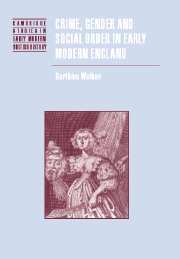Book contents
- Frontmatter
- Contents
- List of figures and tables
- Preface
- Note on quotations and dates
- List of abbreviations
- 1 Introduction
- 2 Men's non-lethal violence
- 3 Voices of feminine violence
- 4 Homicide, gender and justice
- 5 Theft and related offences
- 6 Authority, agency and law
- 7 Conclusion
- Bibliography
- Index
- Titles in the series
5 - Theft and related offences
Published online by Cambridge University Press: 14 July 2009
- Frontmatter
- Contents
- List of figures and tables
- Preface
- Note on quotations and dates
- List of abbreviations
- 1 Introduction
- 2 Men's non-lethal violence
- 3 Voices of feminine violence
- 4 Homicide, gender and justice
- 5 Theft and related offences
- 6 Authority, agency and law
- 7 Conclusion
- Bibliography
- Index
- Titles in the series
Summary
Various forms of theft – petty and grand larceny, housebreaking, burglary, pickpocketing, robbery including highway robbery, and horse-theft – together constituted some three-quarters of felonies prosecuted in early modern England. Everywhere, men were a majority of defendants; of over a thousand offences so prosecuted in Cheshire, more than three-quarters of the suspects were male. Histories of crime have inadequately accounted for this fundamental gender discrepancy. While few studies have dealt with gender per se, their methodological and conceptual frameworks have been geared to male offenders, though this usually remains unacknowledged. Conclusions about criminality therefore often apply to men but not necessarily to the significant minority of female offenders. Moreover, the ‘low’ level of female involvement in property crime is interpreted as a relative numerical insignificance, which in turn leads to an assumption that women's thefts are less significant in other ways too. Hence, female criminality is characterised as petty criminality. Comments about women thieves tend to be underpinned by familiar assumptions. Women were routinely more timid and less likely to operate autonomously than men, frequently being mere accessories to ‘real’ (male) crooks. They stole items of little value and immediate use, unlike their more ambitious and serious male counterparts. Because women were less criminally inclined than men, contemporaries considered them less criminally dangerous. Consequently, generosity and clemency marked women's treatment within the criminal justice system. This characterisation is not entirely erroneous, but it does require modification.
- Type
- Chapter
- Information
- Crime, Gender and Social Order in Early Modern England , pp. 159 - 209Publisher: Cambridge University PressPrint publication year: 2003

